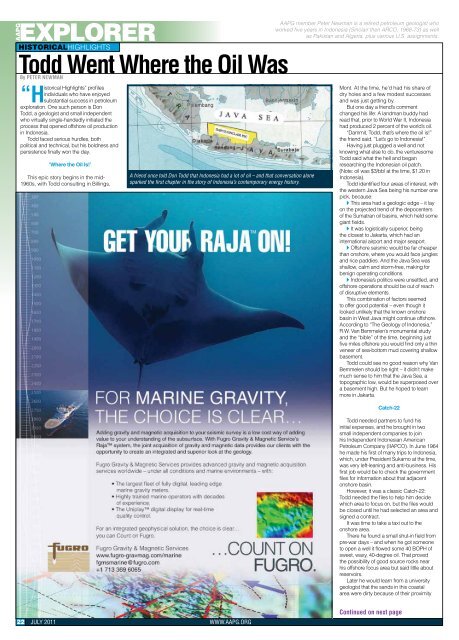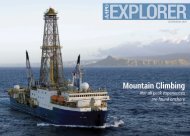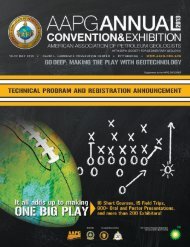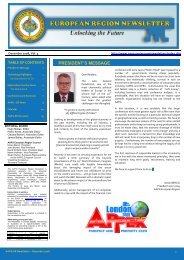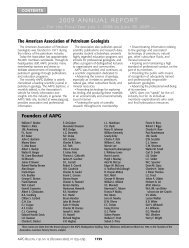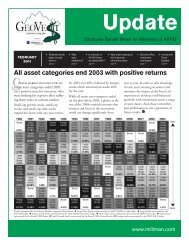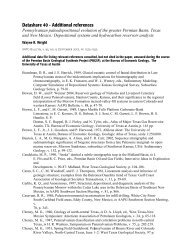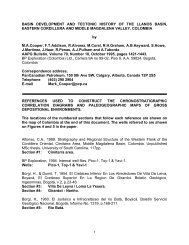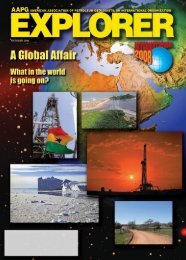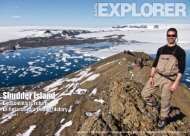AAPG Explorer - American Association of Petroleum Geologists
AAPG Explorer - American Association of Petroleum Geologists
AAPG Explorer - American Association of Petroleum Geologists
You also want an ePaper? Increase the reach of your titles
YUMPU automatically turns print PDFs into web optimized ePapers that Google loves.
<strong>AAPG</strong><br />
EXPLORER<br />
HISTORICALHIGHLIGHTS<br />
Todd Went Where the Oil Was<br />
By PETER NEWMAN<br />
Highlights” pr<strong>of</strong>iles<br />
individuals who have enjoyed<br />
“Historical<br />
substantial success in petroleum<br />
exploration. One such person is Don<br />
Todd, a geologist and small independent<br />
who virtually single-handedly initiated the<br />
process that opened <strong>of</strong>fshore oil production<br />
in Indonesia.<br />
Todd faced serious hurdles, both<br />
political and technical, but his boldness and<br />
persistence finally won the day.<br />
‘Where the Oil Is!’<br />
This epic story begins in the mid-<br />
1960s, with Todd consulting in Billings,<br />
A friend once told Don Todd that Indonesia had a lot <strong>of</strong> oil – and that conversation alone<br />
sparked the first chapter in the story <strong>of</strong> Indonesia’s contemporary energy history.<br />
22 JULY 2011 WWW.<strong>AAPG</strong>.ORG<br />
<strong>AAPG</strong> member Peter Newman is a retired petroleum geologist who<br />
worked five years in Indonesia (Sinclair then ARCO, 1968-73) as well<br />
as Pakistan and Algeria, plus various U.S. assignments.<br />
Mont. At the time, he’d had his share <strong>of</strong><br />
dry holes and a few modest successes<br />
and was just getting by.<br />
But one day a friend’s comment<br />
changed his life: A landman buddy had<br />
read that, prior to World War II, Indonesia<br />
had produced 2 percent <strong>of</strong> the world’s oil.<br />
“Dammit, Todd, that’s where the oil is!”<br />
the friend said. “Let’s go to Indonesia!”<br />
Having just plugged a well and not<br />
knowing what else to do, the venturesome<br />
Todd said what the hell and began<br />
researching the Indonesian oil patch.<br />
(Note: oil was $3/bbl at the time, $1.20 in<br />
Indonesia).<br />
Todd identified four areas <strong>of</strong> interest, with<br />
the western Java Sea being his number one<br />
pick, because:<br />
u This area had a geologic edge – it lay<br />
on the projected trend <strong>of</strong> the depocenters<br />
<strong>of</strong> the Sumatran oil basins, which held some<br />
giant fields.<br />
u It was logistically superior, being<br />
the closest to Jakarta, which had an<br />
international airport and major seaport.<br />
u Offshore seismic would be far cheaper<br />
than onshore, where you would face jungles<br />
and rice paddies. And the Java Sea was<br />
shallow, calm and storm-free, making for<br />
benign operating conditions.<br />
u Indonesia’s politics were unsettled, and<br />
<strong>of</strong>fshore operations should be out <strong>of</strong> reach<br />
<strong>of</strong> disruptive elements.<br />
This combination <strong>of</strong> factors seemed<br />
to <strong>of</strong>fer good potential – even though it<br />
looked unlikely that the known onshore<br />
basin in West Java might continue <strong>of</strong>fshore.<br />
According to “The Geology <strong>of</strong> Indonesia,”<br />
R.W. Van Bemmelen’s monumental study<br />
and the “bible” <strong>of</strong> the time, beginning just<br />
five miles <strong>of</strong>fshore you would find only a thin<br />
veneer <strong>of</strong> sea-bottom mud covering shallow<br />
basement.<br />
Todd could see no good reason why Van<br />
Bemmelen should be right – it didn’t make<br />
much sense to him that the Java Sea, a<br />
topographic low, would be superposed over<br />
a basement high. But he hoped to learn<br />
more in Jakarta.<br />
Catch-22<br />
Todd needed partners to fund his<br />
initial expenses, and he brought in two<br />
small independent companies to join<br />
his Independent Indonesian <strong>American</strong><br />
<strong>Petroleum</strong> Company (IIAPCO). In June 1964<br />
he made his first <strong>of</strong> many trips to Indonesia,<br />
which, under President Sukarno at the time,<br />
was very left-leaning and anti-business. His<br />
first job would be to check the government<br />
files for information about that adjacent<br />
onshore basin.<br />
However, it was a classic Catch-22:<br />
Todd needed the files to help him decide<br />
which area to focus on, but the files would<br />
be closed until he had selected an area and<br />
signed a contract.<br />
It was time to take a taxi out to the<br />
onshore area.<br />
There he found a small shut-in field from<br />
pre-war days – and when he got someone<br />
to open a well it flowed some 40 BOPH <strong>of</strong><br />
sweet, waxy, 40-degree oil. That proved<br />
the possibility <strong>of</strong> good source rocks near<br />
his <strong>of</strong>fshore focus area but said little about<br />
reservoirs.<br />
Later he would learn from a university<br />
geologist that the sands in this coastal<br />
area were dirty because <strong>of</strong> their proximity<br />
Continued on next page


